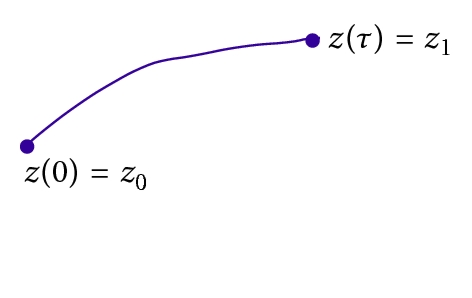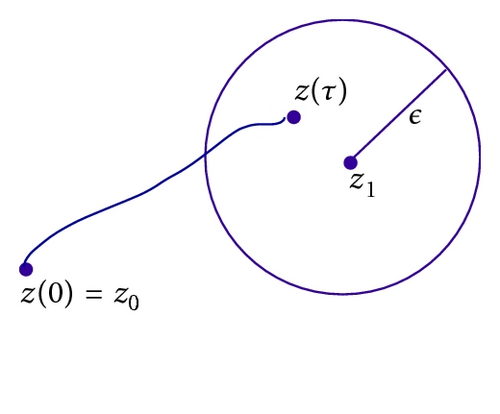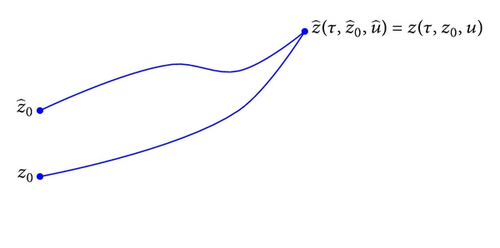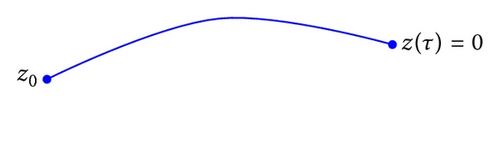A Characterization of Semilinear Dense Range Operators and Applications
Abstract
We characterize a broad class of semilinear dense range operators GH : W → Z given by the following formula, GHw = Gw + H(w), w ∈ W, where Z, W are Hilbert spaces, G ∈ L(W, Z), and H : W → Z is a suitable nonlinear operator. First, we give a necessary and sufficient condition for the linear operator G to have dense range. Second, under some condition on the nonlinear term H, we prove the following statement: If , then and for all z ∈ Z there exists a sequence {wα ∈ Z : 0 < α ≤ 1} given by wα = G*(αI + GG*) −1(z − H(wα)), such that . Finally, we apply this result to prove the approximate controllability of the following semilinear evolution equation: z′ = Az + Bu(t) + F(t, z, u(t)), z ∈ Z, u ∈ U, t > 0, where Z, U are Hilbert spaces, A : D(A) ⊂ Z → Z is the infinitesimal generator of strongly continuous compact semigroup {T(t)} t≥0 in Z, B ∈ L(U, Z), the control function u belongs to L2(0, τ; U), and F : [0, τ] × Z × U → Z is a suitable function. As a particular case we consider the controlled semilinear heat equation.
1. Introduction
It is well known from functional analysis that continuous linear surjective operators form an open set in the space of such operators; that is to say, if a surjective linear continuous operator is added to a linear continuous operator with a small enough norm, the resulting operator is still surjective; moreover, if a linear continuous surjective operator is perturbed by a nonlinear Lipschitz operator with a Lipschitz constant small enough, then the resulting operator is still surjective. This result is not true anymore for continuous linear operators that only have dense range; for instance, if a dense range continuous linear operator is perturbed by another linear operator with norm infinitely small, the resulting operator may not have dense range; in other words, the property of having dense range is not robust enough to be surjective. However, in this paper we proved the following statement: if a continuous linear operator with dense range is perturbed by a compact nonlinear operator with bounded range, then the resulting operator also has dense range. This result can have an unlimited number of applications, not only in the study of control theory for semilinear evolution equations, but it can also be used to find the approximate solution of functional equations in Hilbert spaces giving a formula for the error of this approximation, which is very important from the standpoint of numerical analysis. In addition, it is well known that approximate controllability is much more natural and common than exact controlabilidad, since most of the mechanical processes are diffusive, which implies that these systems can never be exactly controllable; and many years have passed to present a general result on semilinear operators with dense range to facilitate the study of the approximate controlabilidad for a large class of semilinear evolution equations whose dynamics are given by compact semigroups. However, in this work, by way of illustration, we only show how this result can be applied to study the approximate controllability of control systems governed by the semilinear heat equation.
Specifically, in this paper we characterize a broad class of semilinear dense range operators.
Remark 1 (see [2]–[4].)The function F is smooth enough if
- (a)
the mild solutions z(u) = zu of (5) are unique,
- (b)
the mild solutions z(u) = zu depends continuously on u,
- (c)
and if F is a Lipschitz function, then z(u) = zu, as a function of u, is also a Lipchitz function.
As an application we consider the following example of controlled semilinear heat equation.
Example 2 (the interior controllability of the nD heat equation). The semilinear heat equation was studied in [8] where the authors prove the interior controllability of the following control system:
We note that the interior approximate controllability of the linear heat equation,
The approximate controllability of the heat equation under nonlinear perturbation f(z) independents of t and u variables,
Our result can be applied also to the semilinear Ornstein-Uhlenbeck equation, the Laguerre equation, and the Jacobi equation. Specifically, in [8], the following well-known example of reaction diffusion equations is studied.
- (1)
The interior controllability of the semilinear Ornstein-Uhlenbeck equation
() -
where u ∈ L2(0, τ; L2(𝔑d, μ)), is the Gaussian measure in 𝔑d, ω is an open nonempty subset of 𝔑d, and the nonlinear function f : [0, τ] × 𝔑 × 𝔑 → 𝔑 is smooth enough and there are constants a, c ∈ 𝔑, with c ≠ −1, such that
() -
where qτ = [0, τ] × 𝔑 × 𝔑.
- (2)
The interior controllability of the semilinear Laguerre equation
() -
where , is the Gamma measure in , ω is an open nonempty subset of , and nonlinear function f : [0, τ] × 𝔑 × 𝔑 → 𝔑 is smooth enough and there are constant a, c ∈ 𝔑, with c ≠ −1, such that
() -
where qτ = [0, τ] × 𝔑 × 𝔑.
- (3)
The interior controllability of the semilinear Jacobi equation
() -
where t > 0, x ∈ [−1,1] d, u ∈ L2(0, τ; L2([−1,1] d, μα,β)), is the Jacobi measure in [−1,1] d, ω is an open nonempty subset of [−1,1] d, and the nonlinear function f : [0, τ] × 𝔑 × 𝔑 → 𝔑 is smooth enough and there are constants a, c ∈ 𝔑, with c ≠ −1, such that
() -
where qτ = [0, τ] × 𝔑 × 𝔑.
2. Dense Range Linear Operators
In this section we shall present a characterization of dense range bounded linear operators. To this end, we denote by L(W, Z) the space of linear and bounded operators mapping W to Z, endowed with the uniform convergence norm, and we will use the following lemma from [16] in Hilbert space.
Lemma 4. Let G* ∈ L(Z, W) be the adjoint operator of G ∈ L(W, Z). Then the following statements hold:
- (i)
Rang (G) = Z⇔∃γ > 0 such that
() - (ii)
.
-
The following lemma follows from Lemma 4 (ii).
Lemma 5 (see [1], [7], [8], [16]–[22].)The following statements are equivalent:
- (a)
,
- (b)
Ker (G*) = {0},
- (c)
〈GG*z, z〉>0, z ≠ 0 in Z,
- (d)
,
- (e)
for all z ∈ Z we have Gwα = z − α(αI + GG*) −1z, where
() -
So, lim α→0Gwα = z and the error Eαz of this approximation is given by the formula
()
Remark 6. Lemma 5 implies that the family of linear operators Γα : Z → W, defined for 0 < α ≤ 1 by
Proposition 7. If the , then
Proof. If , then from Lemma 4(ii) we have that
Proposition 8. If for some β ∈ (0,1] one has that
Proof. Suppose that ∥β(βI + GG*) −1∥<1. Then, from the following identity:
Corollary 9. If and Rang (G) ≠ Z, then
3. Dense Range Semilinear Operators
In this section we shall look for conditions under which the semilinear operator
Theorem 10. If , H is continuous, and is compact, then , and for all z ∈ Z there exists a sequence {wα ∈ Z : 0 < α ≤ 1} given by
Proof. For each z ∈ Z fixed we shall consider the following family of nonlinear operators Kα : W → W given by
Since is compact, without loss of generality, we can assume that the sequence H(wα) converges to y ∈ Z as α → 0. So, if we consider
4. Controllability of Nonlinear Evolution Equations
We observe that the controllability of semilinear systems has been studied by several authors, particularly interesting is the work done by [18–26].
Definition 11 (exact controllability). The system (48) is said to be exactly controllable on [0, τ] if for every z0, z1 ∈ Z there exists u ∈ L2(0, τ; U) such that the mild solution z(t) of (48) corresponding to u verifies

Definition 12 (approximate controllability). The system (48) is said to be approximately controllable on [0, τ] if for every z0, z1 ∈ Z, ε > 0 there exists u ∈ L2(0, τ; U) such that the solution z(t) of (48) corresponding to u verifies

Definition 13 (controllability to trajectories). The system (48) is said to be controllable to trajectories on [0, τ] if for every and there exists u ∈ L2(0, τ; U) such that the mild solution z(t) of (48) corresponding to u verifies:

Definition 14 (null controllability). The system (48) is said to be null controllable on [0, τ] if for every z0 ∈ Z there exists u ∈ L2(0, τ; U) such that the mild solution z(t) of (48) corresponding to u verifies:

Remark 15. It is clear that exact controllability of the system (48) implies approximate controllability, null controllability, and controllability to trajectories of the system. But, it is well known [27] that due to the diffusion effect or the compactness of the semigroup generated by −Δ, the heat equation can never be exactly controllable. We observe also that the linear case controllability to trajectories and null controllability are equivalent. Nevertheless, the approximate controllability and the null controllability are in general independent. Therefore, in this paper we will concentrated only on the study of the approximate controllability of the system (48).
Now, we shall describe the strategy of this work:
First, we characterize the approximate controllability of the auxiliary linear system
Finally, the approximate controllability of the system (55) follows from the controllability of (54), the compactness of the semigroup generated by the operator A, the uniform boundedness of the nonlinear term G, and applying Schauder fixed point theorem.
Remark 16. If c ≠ 1 and B = B1, then the system z′ = Az + Bu(t) is approximately controllable if and only if the system (55) is approximately controllable.
4.1. The Linear System
Definition 17. For the system (54) we define the following concept: the controllability map (for τ > 0) Ga : L2(0, τ; U) → Z is given by
The following lemma follows from Lemma 5.
Lemma 18. Equation (54) is approximately controllable on [0, τ] if and only if one of the following statements holds:
- (a)
,
- (b)
,
- (c)
, z ≠ 0 in Z,
- (d)
,
- (e)
, ∀t ∈ [0, τ], ⇒z = 0,
- (f)
for all z ∈ Z one has , where
() -
So, lim α→0Gauα = z and the error Eαz of this approximation is given by the formula
()
Remark 19. Lemma 5 implies that the family of linear operators Γα : Z → L2(0, τ; U), defined for 0 < α ≤ 1 by
4.2. The Semilinear System
Definition 20. For the system (55) we define the following concept: the nonlinear controllability map (for τ > 0) Gg : L2(0, τ; U) → Z is given by
Lemma 21. Equation (55) is approximately controllable on [0, τ] if and only if .
Definition 22. The following equation will be called the controllability equations associated to the nonlinear equation (55)
Now, we are ready to present a result on the approximate controllability of the semilinear evolutions equation (48).
Theorem 23. If the linear system (54) is approximately controllable, then system (55) is approximately controllable on [0, τ]. Moreover, a sequence of controls steering the system (55) from initial state z0 to an ϵ neighborhood of the final state z1 at time τ > 0 is given by the formula
Proof. From Theorem 10, it is enough to prove that the function H given by (103) is continuous and is a compact set, which follows from the compactness of the semigroup {T(t)} t≥0, the smoothness and the boundedness of the nonlinear term G (see [8, 27]).
So, putting z = z1 − eaτT(τ)z0 and using (65), we obtain the desired result
5. Application to the Nonlinear Heat Equation
As an application of this result we shall prove the controllability of the semilinear nD heat equation (6). To this end, we shall use the following strategy:
Then to prove the controllability of the linear equation (72), we use the classical Unique Continuation Principle for Elliptic Equations (see [28]) and the following results.
Lemma 24 (see Lemma 3.14 from [16], page 62.)Let {αj} j≥1 and {βi,j : i = 1,2, …, m} j≥1 be two sequences of real numbers such that: α1 > α2 > α3⋯. Then
Finally, the approximate controllability of the system (73) follows from the controllability of (72), the compactness of the semigroup generated by the Laplacean operator Δ, and the uniform boundedness of the nonlinear term g by applying Theorem 23.
5.1. Abstract Formulation of the Problem
In this part we choose a Hilbert space where system (6) can be written as an abstract differential equation; to this end, we consider the following notations.
- (i)
There exists a complete orthonormal set {ϕj,k} of eigenvectors of A = −Δ.
- (ii)
For all z ∈ D(A) we have
() -
where 〈·, ·〉 is the inner product in Z and
() -
So, {Ej} is a family of complete orthogonal projections in Z and .
- (iii)
−A generates a compact analytic semigroup {T(t)} given by
()
5.2. The Linear Heat Equation
Definition 25. For the system (80) we define the following concept: the controllability map (for τ > 0) Ga : L2(0, τ; U) → Z is given by
Lemma 26. Equation (80) is approximately controllable on [0, τ] if and only if one of the following statements holds:
- (a)
,
- (b)
,
- (c)
, z ≠ 0 in Z,
- (d)
,
- (e)
, ∀t ∈ [0, τ], ⇒z = 0,
- (f)
for all z ∈ Z one has , where
() -
So, lim α→0Gauα = z and the error Eαz of this approximation is given by
()
Theorem 27. The system (80) is approximately controllable on [0, τ]. Moreover, a sequence of controls steering the system (80) from initial state z0 to an ϵ neighborhood of the final state z1 at time τ > 0 is given by
Proof. It is enough to show that the restriction of Ga to the space L2(0, τ; L2(ω)) has range dense; that is, or . Consequently, Ga,ω : L2(0, τ; L2(ω)) → Z takes the following form:
5.3. The Semilinear Heat Equation
Definition 28. For the system (81) we define the following concept: the nonlinear controllability map (for τ > 0) Gg : L2(0, τ; U) → Z is given by
The following lemma is trivial.
Lemma 29. Equation (81) is approximately controllable on [0, τ] if and only if .
Definition 30. The following equation will be called the controllability equations associated to the nonlinear equation (81):
Now, we are ready to present a result on the interior approximate controllability of the semilinear nD heat equation (6).
6. Conclusion
We believe that these results can be applied to a broad class of reaction diffusion equation like the following well-known systems of partial differential equations.
Example 32. The thermoelastic plate equation
Example 33. The equation modelling the damped flexible beam:
Example 34. The strongly damped wave equation with Dirichlet boundary conditions:
Acknowledgments
This work has been supported by CDCHT-ULA-C-1796-12-05-AA and BCV.




